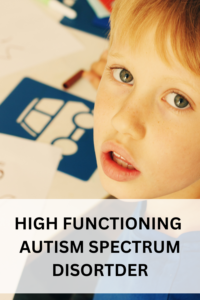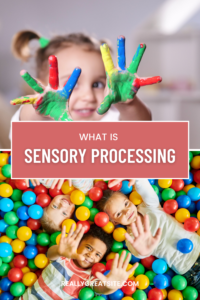Navigating the Journey of High Functioning Autism Spectrum Disorder
Are you a parent or caregiver of a child with high functioning autism spectrum disorder? Maybe you are curious and want to learn more about it. Maybe you are wondering if your child could be on the autism spectrum or has high functioning autism.
If so, you are not alone. Autism is becoming more and more common, and it is important that everyone is more aware of how truly neurodiverse our population is. In this blog post, we will dive into the wonders of high functioning autism spectrum disorder.
This post was created by Marra Robert, OTD, OTRL.

Discovering that your child has been diagnosed with High-Functioning Autism Spectrum Disorder can be an overwhelming experience for any parent. However, it’s essential to understand that a diagnosis is just the beginning of a unique journey filled with opportunities for growth, learning, and connection.
Hi! My name is Marra and I’m a mama and a pediatric occupational therapist who has years of experience working with children with autism and helping their parents navigate the ups and downs of child development.
I loved being a support person for parents learning about autism, high functioning autism spectrum disorder, sensory processing, and their child’s individual needs.
In this comprehensive guide, we’ll explore what high-functioning autism is, discuss key characteristics, and provide practical strategies for parents and children to thrive together.

UNDERSTANDING HIGH FUNCTIONING AUTISM SPECTRUM DISORDER
High-Functioning Autism Spectrum Disorder is a term used to describe individuals on the autism spectrum who have average to above-average intellectual abilities. While each person with high functioning autism spectrum disorder is unique, there are some common characteristics that may be present:
1. Social Challenges: Individuals with high functioning autism spectrum disorder often struggle with social interactions. They may find it challenging to understand social cues, make eye contact, or engage in reciprocal conversations. This doesn’t mean they lack a desire for social connection; rather, they may need additional support in navigating social situations.
2. Repetitive Behaviors and Interests: Repetitive behaviors, such as hand-flapping or rocking, and intense, narrow interests are common in individuals with high functioning autism spectrum disorder. These repetitive behaviors can serve as a source of comfort and predictability for them.
3. Sensory Sensitivities: Many individuals with high functioning autism spectrum disorder experience heightened sensitivities to sensory stimuli, such as lights, sounds, textures, or smells. Understanding and addressing these sensitivities can significantly improve their overall well-being.
4. Communication Challenges: While individuals with high functioning autism spectrum disorder may have strong language skills, they might struggle with pragmatic language (the social use of language), making it difficult to understand nuances, jokes, or sarcasm. Some individuals may also have difficulty with nonverbal communication, such as body language and facial expressions.

NAVIGATING THE EDUCATIONAL LANDSCAPE
Parents of children with high functioning autism apectrum disorder often face unique challenges in the educational setting. Here are some strategies to help ensure a positive and supportive learning environment:
1. Individualized Education Plan (IEP): Work closely with the school to develop an IEP tailored to your child’s needs. This document outlines specific goals, accommodations, and support services to facilitate their academic and social success.
2. Social Skills Training: Collaborate with educators to incorporate social skills training into the curriculum. This can include explicit instruction on recognizing emotions, understanding social cues, and practicing effective communication.
3. Sensory-Friendly Classroom: Advocate for a sensory-friendly classroom environment. Simple adjustments, such as minimizing fluorescent lighting, providing noise-canceling headphones, or offering a designated quiet space, can significantly benefit a child with high functioning autism spectrum disorder.

BUILDING SOCIAL CONNECTION
Creating opportunities for social interaction is crucial for children with high functioning autism spectrum disorder. Here are some strategies to foster meaningful connections:
1. Structured Playdates: Plan playdates with a clear structure and defined activities. Providing a framework for social interaction can make it more enjoyable and less overwhelming for a child with high functioning autism syndrome disorder.
2. Joining Social Groups: Encourage participation in clubs or groups aligned with your child’s interests. Shared interests can serve as a foundation for building friendships and provide a sense of belonging.
3. Teaching Social Skills: Work collaboratively with therapists, teachers, or support groups to teach and reinforce essential social skills. Role-playing scenarios and discussing appropriate responses can enhance your child’s social competence.
SUPPORTING EMOTIONAL REGULATION
Many individuals with high functioning autism spectrum disorder experience challenges in regulating their emotions. Here are strategies to help promote emotional well-being:
1. Visual Supports: Utilize visual supports, such as emotion charts or social stories, to help your child understand and express their emotions. These tools provide a visual guide for navigating complex social and emotional situations.
2. Mindfulness and Relaxation Techniques: Introduce mindfulness and relaxation techniques to help your child manage stress and anxiety. Activities like deep breathing exercises, progressive muscle relaxation, or yoga can be effective tools for emotional regulation.
3. Establishing Routines: Establishing predictable routines can provide a sense of stability and security for individuals with high functioning spectrum disorder. Clearly defined schedules help reduce anxiety by creating a structured and organized daily environment.

PARENTAL SELF CARE
Caring for a child with high functioning autism spectrum disorder can be demanding, and it’s essential for parents to prioritize self-care. Here are some tips to navigate the challenges while maintaining your well-being:
1. Seek Support: Connect with other parents of children with high functioning autism spectrum disorder through support groups or online communities. Sharing experiences, insights, and advice can be immensely valuable.
2. Respite Care: Take advantage of respite care services to ensure you have time for self-care and personal pursuits. Balancing your own needs with the demands of parenting is crucial for long-term well-being.
3. Educate Yourself: Stay informed about high functioning autism spectrum disorder by reading reputable sources, attending workshops, and seeking guidance from professionals. Knowledge empowers you to advocate effectively for your child and navigate the complexities of their unique challenges.
Parenting a child with High-Functioning Autism Spectrum Disorder is a journey filled with both triumphs and challenges. By understanding the unique characteristics of high functioning authors spectrum disorder, collaborating with educators and therapists, and fostering a supportive and accepting environment, parents can empower their children to thrive socially, academically, and emotionally.
Remember, every individual with high functioning spectrum disorder is unique, and with patience, understanding, and advocacy, you can help your child reach their full potential and lead a fulfilling and meaningful life.

